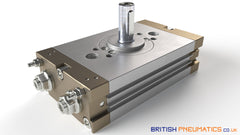Differences Between Pneumatic and Electric Actuation
Differences Between Pneumatic and Electric Actuation
Actuators are important components of any machine and are the “key movers” that produce physical movements, such as the extension of a cylinder rod, which we find useful. More generally, actuators help convert various forms of energy into mechanical force. The sources of energy can be electrical, hydraulic, or pneumatic ( by way of compressed air).
In this article, we will compare and contrast electric actuators with pneumatic actuators. As we shall see, the two have their own uses.

Pneumatic actuators convert compressed air or gas into kinetic energy. This kinetic energy can be used in multiple locations to mobilize components of complex machines without direct human involvement. These actuators are particularly handy in automation or emergency shutdowns.
Pneumatic actuators may produce linear or rotary mechanical force depending their design.
Electric Actuators:
Electric actuators turn electric energy into motion. It can also produce either linear or rotary motion depending upon the design. Most designs incorporate a DC (sometimes, AC) motor, of varying size, within the device. Electrical current allow for the motor to spin, which then gets translated into some mechanical movement.
Thus, electric actuation is unllike pneumatic applications, where a motor is present only in the compressor, which is able to produce energy en masse and an in efficient manner.
Differences Between Pneumatic and Electric Actuators:
- Greater Force and Velocity – Pneumatic actuators are ideal to use if you need more speed and force in the system. Pneumatic actuators also allow you to regulate the pressure and velocity input to the machine or device. While electric actuators come second when it comes to the intensity of force and speed.
- Energy Consumption: Even when they are not moving, electric actuators require a set amount of essential power. This fundamental power operates the controller and keeps the load in place. While at a halt, pneumatic cylinders require much less energy. Hence pneumatic actuators are more efficient when the stop time is greater.
- Manufacturing Expense – Electric actuators are costly because their components are expensive to buy, while pneumatic actuators offer very low manufacturing costs. So if you are looking for cost effective actuators, pneumatic ones should be your first choice.
- Heat Resistance – Electric actuators have been known to be less heat resistant. It is difficult to maintain a lower heat coefficient when using electric actuators while pneumatic actuators can withstand a wide range of temperatures i.e. -4 and 175°F. With a little modification, this range can expand up to -40 to 250°F.
- Maintenance Cost – While pneumatic actuators have low component costs, their operating costs are relatively higher than electric actuators.
- Moisture – Pneumatic actuators are well resistant to moisture. It only causes slight problems when moisture is combined with very low temperatures. At very low temperatures, the air may condensate and meddle with its operation. While electric actuators are quite sensitive to moisture. Hence using electric actuators outdoors requires a lot of care and sealing.
- Halting Operations – Pneumatic actuators are easy to stop, while electric ones cannot be halted during the operation.
- Torque to Weight Ratio – When compared to electric actuators, pneumatic actuators have a higher torque-to-weight ratio.
- Fail-Safe Option Availability – also known as spring return is a safety feature that ensures the operations stop immediately and return to starting position in case of power or signal failure. This feature is offered in pneumatic actuators only.
- Other Safety Features: Pneumatic actuators are generally explosion proof, shock or spark safe while electric ones need NEMA modification for extreme environments.
British Pneumatics is a UK based distributor specializing in pneumatics. We also educate our clientele regarding pneumatic components and their usages.
